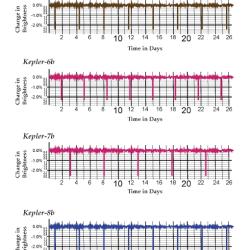Source Institutions
Source Institutions
Add to list Go to activity
Activity link broken? See if it's at the internet archive

In this space science activity, learners explore transits and the conditions when a transit may be seen. Learners use models to investigate how a planet's size and distance from its star affects the behavior of transits. Learners also use mathematics to interpret graphs of brightness vs. time to deduce information about planet-star systems. This lesson includes educator instructions, photocopy masters for Transit Light Curves, Option Math for Transit Tracks, Kepler’s 3rd Law graphs, cube root tables, an account of Jeremiah Horrocks' 1639 observation of the transit of Venus, and an answer key for the Transit Tracks Light Curves.
- Under 5 minutes
- 45 to 60 minutes
- $1 - $5 per group of students
- Ages 11 - 18
- Activity, Demonstration, Lesson/Lesson Plan, Model
- English
Quick Guide
Materials List (per group of students)
- Clip-on lamp with frosted spherically shaped low wattage (25 W maximum) bulb
- 4 beads, various sizes (3-12 mm) and colors of threads of various lengths (20-100cm; For best results, use black thread)
- Transit Light Curves (p.4-8)
- Worksheets (p.9-13)
- Account of Jeremiah Horrocks observations of the transit of Venus (p.14)
- Light sensor and computer with sensor interface and graphing function (optional)
- Johannes Kepler information (optional)
Subjects
-
Earth and Space Science
-
Astronomy
- Stars and Galaxies
-
Solar System
- The Sun
- The Planets
-
Astronomy
-
Physical Sciences
-
Motion and Forces
- Kepler's Laws
- Rotation Motion
-
Motion and Forces
-
Mathematics
- Algebra
-
Data Analysis and Probability
- Data Analysis
- Data Collection
-
Measurement
- Circles
-
Number and Operations
- Exponents
- Representation
-
The Nature of Technology
-
The Design Process
- Problem Solving
-
The Design Process
-
The Nature of Science
-
The Scientific Process
- Conducting Investigations
- Gathering Data
- Formulating Explanations
- Communicating Results
-
The Scientific Process
Audience
To use this activity, learners need to:
- see
- read
- be mobile
Learning styles supported:
- Involves hands-on or lab activities
Other
Components that are part of this resource:
This resource is part of:
Access Rights:
- Free access
By:
Rights:
- All rights reserved, Regents of The University of California, 2008
